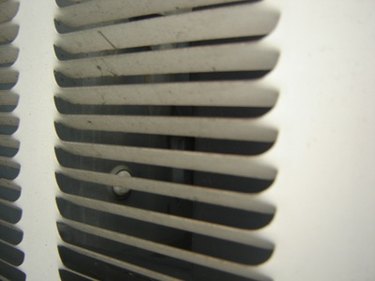
Fungi are primitive organisms belonging to one of the five kingdoms of life that inhabit the earth. Fungi (molds) cannot make their own food, and sustain themselves by living off decaying organic matter in moist environments. Some 1,000 types of mold live in homes in the United States, with about 80 types suspected to cause illness in people, according to Advanced Mold Inspections. Certain fungi prefer the kinds of materials and environments inside houses.
Aspergillus
Video of the Day

Aspergillus is a common indoor mold in many habitats. You can find these fungi on decaying vegetation, in soils, in and on stored food and on stored grains in tropical and subtropical areas. Of the 150 species within this genus, some are parasitic to plants, insects and animals. The entire species produces toxic carcinogens, is allergenic and causes a variety of ailments in people including asthma, edema, bronchiospasms, emphysema and eye and ear infections.
Video of the Day
Cladosporium

Cladosporium is commonly found indoors on fiberglass duct liner surfaces and the interior surfaces of heating and air conditioning supply ducts. It also lives from contact with a wide variety of plants, and can cause mycosis. Symptoms from exposure may include edema, bronchiospasms and emphysema.
Penicillium
The penicillium fungus infests homes with carpet, wallpaper and duct work insulated with fiberglass. Exposure to this fungi can cause asthma. Symptoms may include edema and bronchiospasms and emphysema.
Alternaria
Alternaria is a widespread fungi commonly found in homes on textiles, carpet, window frames and on horizontal surfaces. Alternair alternata produces toxic metabolites that have been connected to disease in humans and animals. Spores deposit themselves in the nose, mouth and upper respiratory tract, and may cause pneumoniti, sinusitis, asthma and other health issues.
Stachybotrys
Some strains of the fungus produce the mycotoxin Satratoxin H., which is poisonous when inhaled. The fungi grow especially well on building materials high in cellulose and with a low nitrogen content. Humidity levels of 55 percent or greater, combined with temperature fluctuations, encourage toxin production. This toxin can cause sore throats, flu symptoms, headache, fatigue, diarrhea and immune system problems. The mycotoxin is a carcinogen to the liver and kidney. It is difficult to collect indoor air samples to identify this fungus unless the spores are physically disturbed.
Absidia
Absidia is an allergenic fungus, and common inside homes. It affects the lungs, sinus, brain, eyes and skin. The cormbifera variety has led to infections in humans with AIDS, abortions in cows and abscesses in cats.